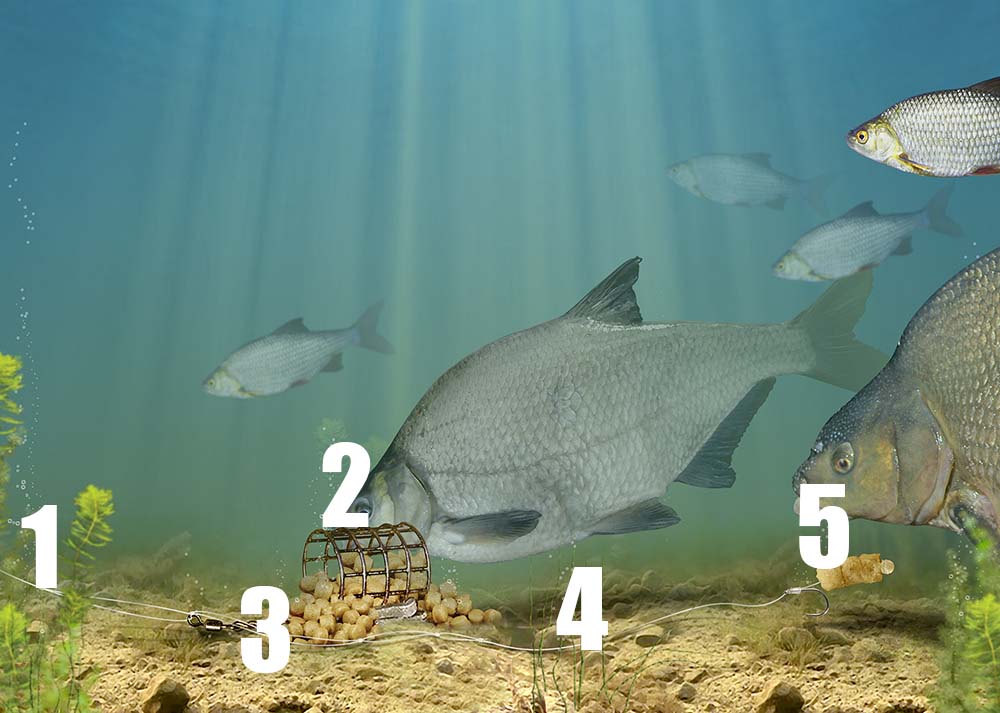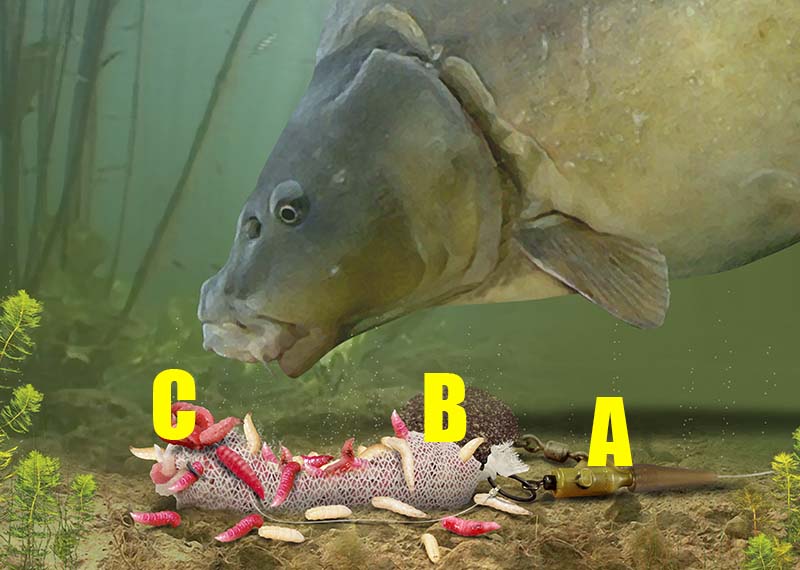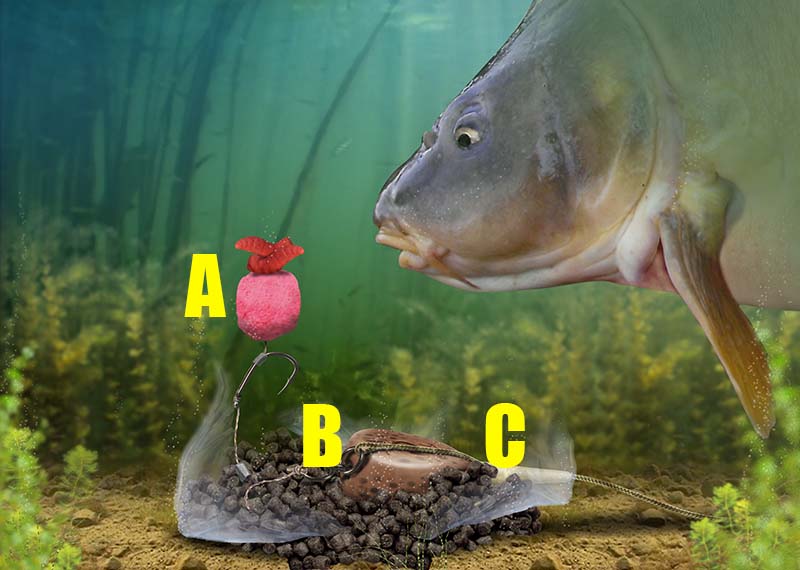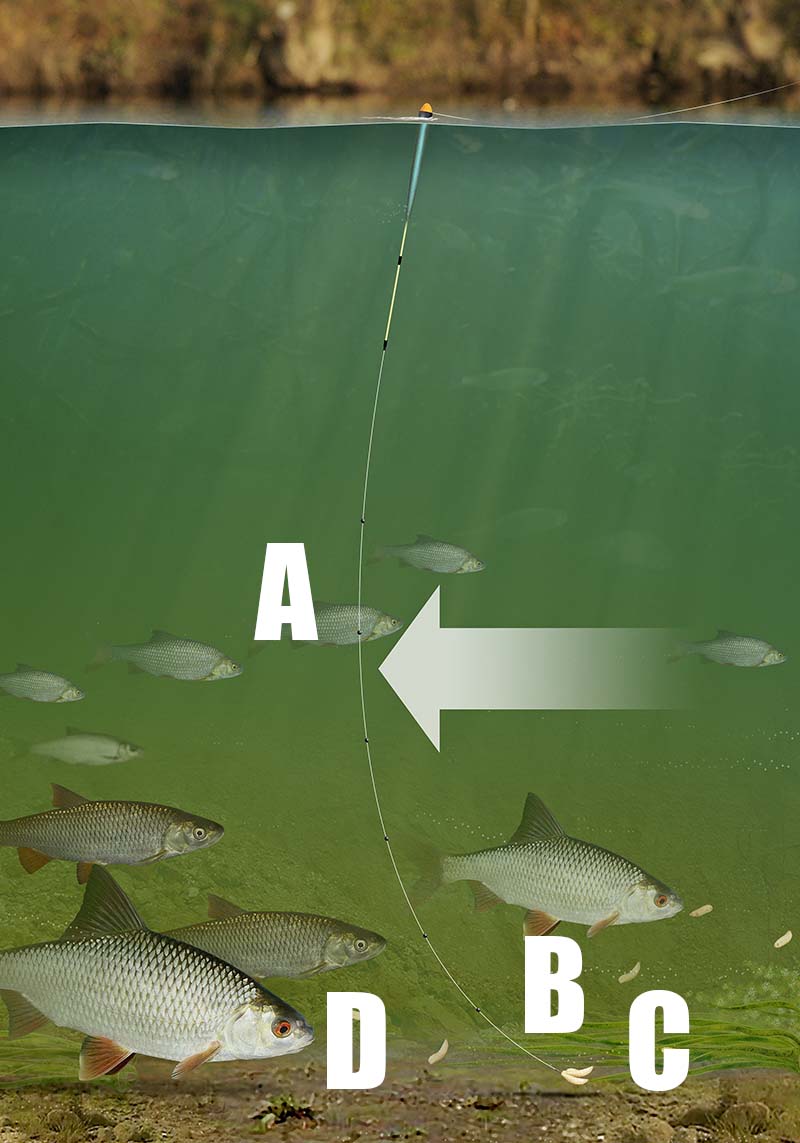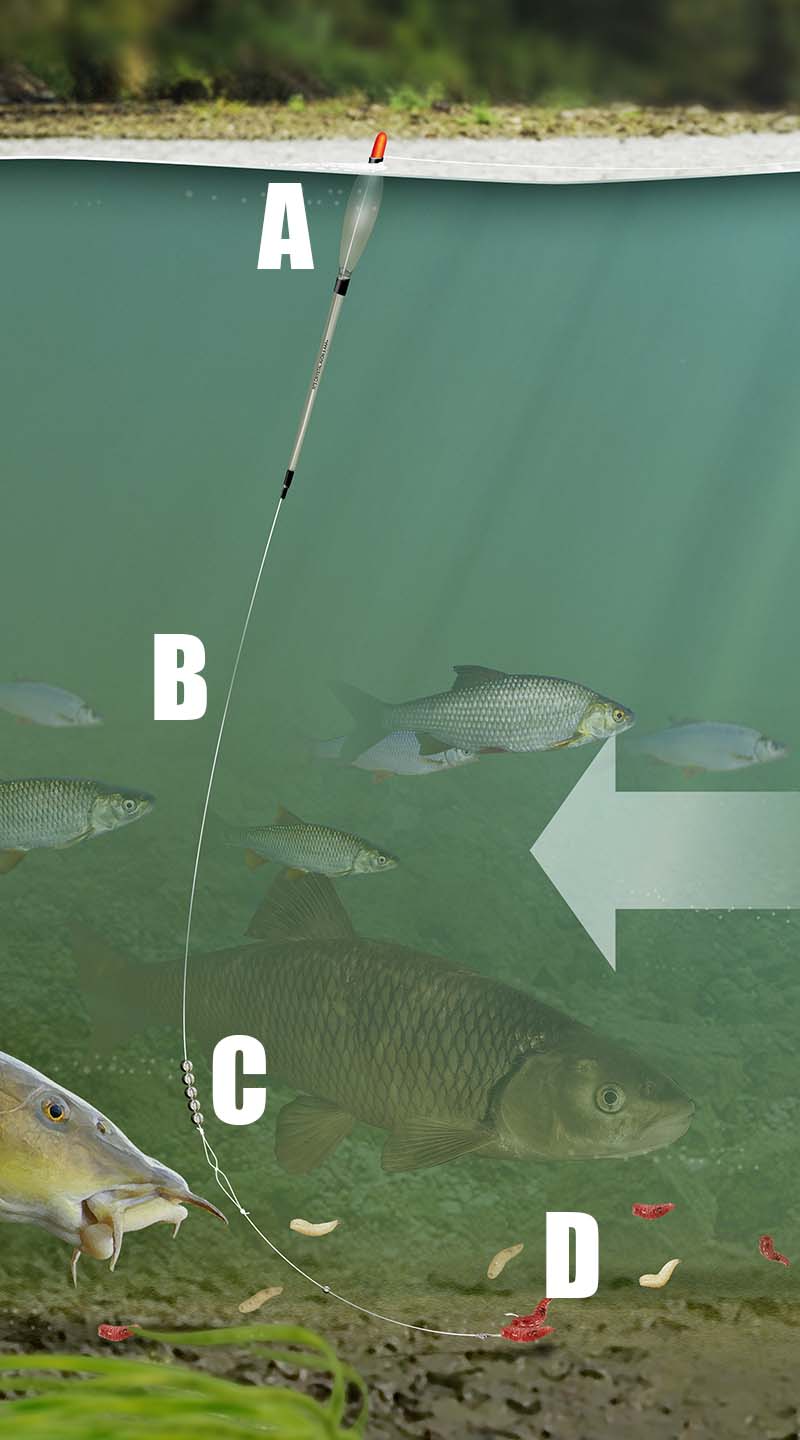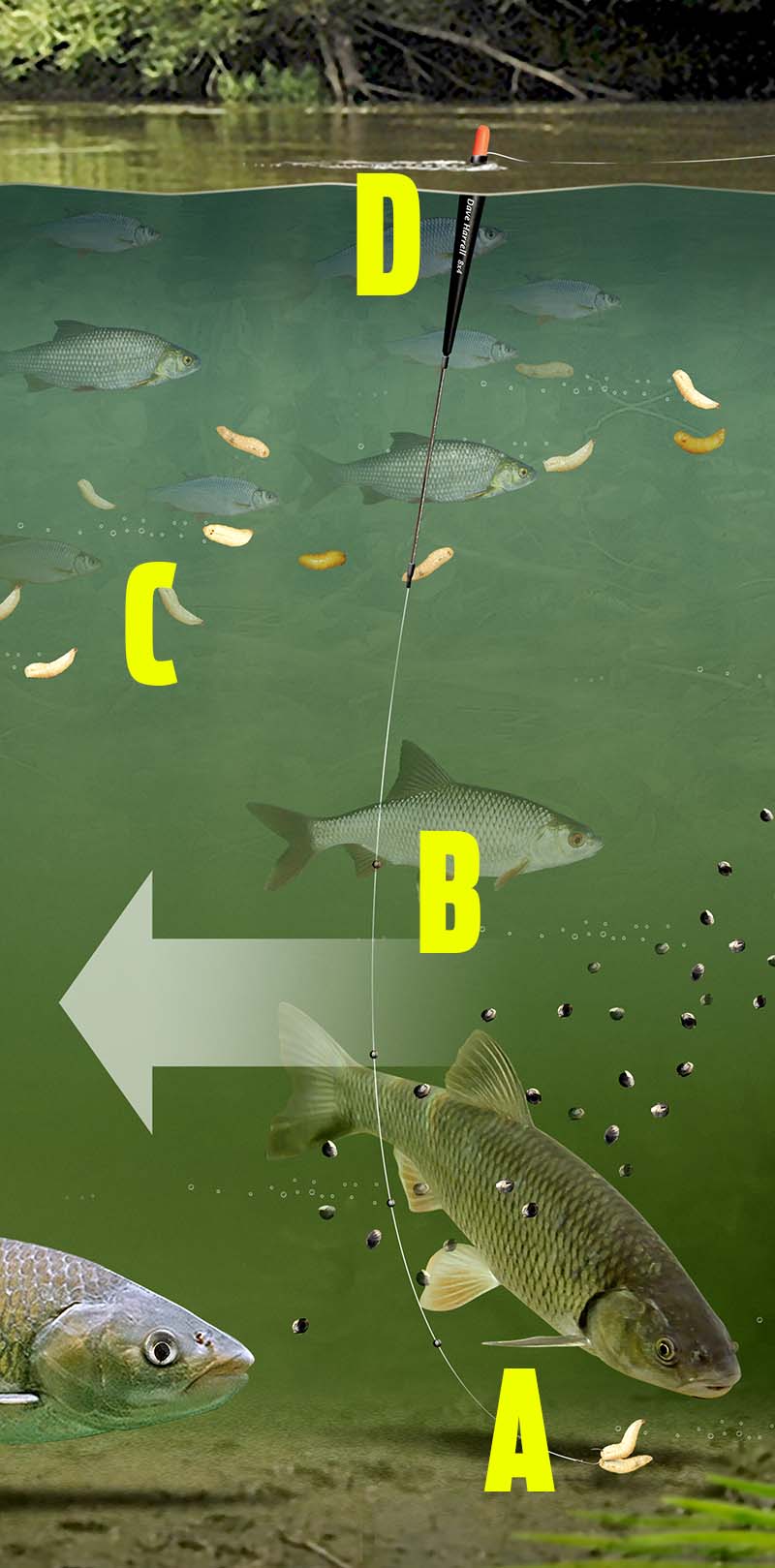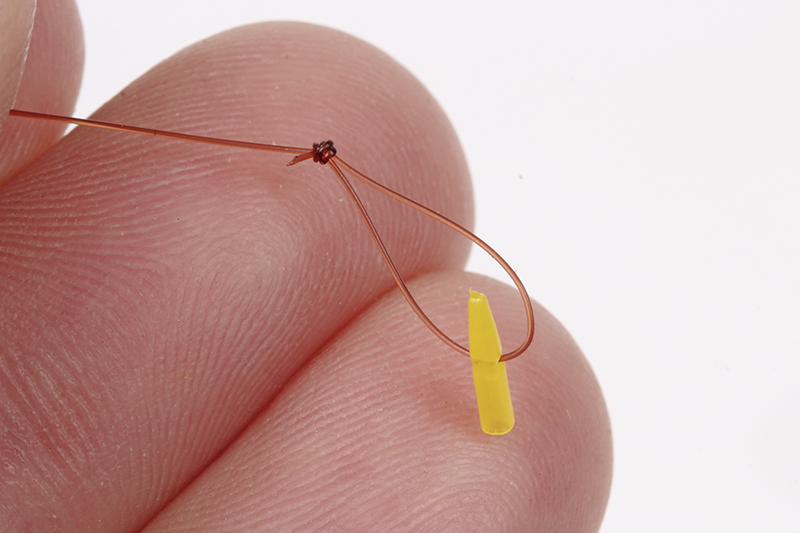Top five knots we all need on the bank
Knowing a few basic knots is a vital part of any angler's skills so we have come up with the top 5 essential knots that you will need to know on the bank-side. Knowing these five knots will really help you expand your angling arsenal.
Palomar
Double 6ins of line and pass it through the hook eye like this.
Tie a single overhand knot in the loop.
Pass the hook or swivel through the loop.
Moisten and pull tight, ensuring the line is neat.
Once the knot is tight, trim the tag end.
Overhand loop
Make a loop of line long enough to work with but not so long that you have to cut lots away when trimming off.
Create a simple overhand loop and pass the end of the line through it.
Make sure you pass the end of the loop twice through, like this.
Draw the loop tight and trim off the loose end. Wet the knot with a little saliva before tightening.
Water knot
Lay the two lengths of line to be connected alongside each other.
Form a loop in both lines, giving you plenty of line to work with.
Pass the two free tags of the lines four times through the loop, like this.
Moisten and tighten carefully, making sure the knot tightens neatly. Trim tag ends to suit your rig.
Grinner Knot
The knotless knot
Tie a bait band or loop for your hair rig at one end of the line. The two-turn grinner shown above is best for fishing with a pellet band.
Pass the opposite end of the line through the back of the hook’s eye and out the front. A small piece of rig tubing on the shank will keep the hair straight.
Take the loose end and make several wraps around the hook shank. WInd the end over the shank and poke through the eye.
While holding the loop end in its desired position, pull the free end tight while working the wraps up to the eye of the hook through the back of the eye.
Pull the end of the line to tighten the knot fully.
How to tie the snowman rig
If you can’t decide whether to use a bottom bait or a pop-up rig, then why not try a snowman instead... it’s the best of both worlds!
In essence, it’s a standard boilie threaded on to a hair rig, with a smaller pop-up threaded on after it. Once on the bottom, the pop-up stands proud, acting like a beacon to any passing carp. Such a bait arrangement allows you to mix and match your baits. For example, you could use a dull, fishy-flavoured bottom boilie, with a bright, fruity pop-up.
Snowman rigs are highly versatile and can be used with any lead set-up, and with just about any length or type of hooklink.
How to tie
Strip back about 6ins of the outer layer from the coated braid. Form a small overhand loop in the end.
Secure a small metal rig ring loosely in place with an overhand knot, just below the hair loop.
Set the rig ring about 1.5ins from end of the loop, then secure firmly with a second granny knot.
Position the rig ring opposite the hook’s barb, then attach the hook using a knotless knot.
At this point you can add a hook aligner over the eye of the hook. This will help with hook-ups.
Finally, add a few small ‘mouse droppings’ of tungsten putty to the hooklink to nail it to the deck.
Top five lures for perch fishing with Sam Edmonds
After the pike, perch and zander have spawned they will be ready to go on a feeding spree. so here are my top five lures that i use when going after perch and zander in spring.
Shad (Berkley Ripple Shad 5cm and 7cm)
The Ripple Shad has a thick paddle tail, and ribs running along the body, which produce lots of vibration when the lure is retrieved – ideal for fishing in coloured canals.
Plastic worm (Berkley Floating Mice Tail)
A plastic worm that works well on a drop shot rig, nose-hooked on a size 6-8 hook. Brown is a great all-round colour, but brighter pink and white lures are great in coloured water.
Crankbait (Berkley Frenzy Flicker Shad Suspending 5cm)
This crankbait dives to around 5ft, great for fishing shallow canals. It covers lots of water quickly, searching out fish, and an internal rattle adds to the enticing action.
Shad (Berkley Powerbait Shrug Minnow 1.5ins)
Rigged on a 1.5g or 2.5g jighead, I use this tiny shad for smaller perch and zander, but it works for big fish too. Orange Glow is a great colour but Cherry Red is a close second.
Twitchtail (Berkley Twitchtail Minnow)
Available in many colours, this is my favourite soft bait for rigging on a drop shot rig to target big perch, but is also great for zander. I like to nose-hook these on a size 2 Owner Mosquito drop shot hook.
How to tie the method feeder rig
Method feeders are a staple among match anglers and, with a few tweaks, can also be used to target big carp, tench and bream.
The only changes you need to make to turn it into a rig capable of landing any carp that swims are to strengthen the component parts and increase the size of the hookbait and loosefeed.
The Method is perfect for ‘runs waters’ or for targeting carp in pressured venues that have seen it all when it comes to rigs.
How to tie the hooklink
Tie on a curved shank hook. We’ve used a palomar knot here, but a grinner is also fine to use.
Thread a micro rig swivelover the point and down the shank, followed by a small hook bead.
Position the hook bead and then attach the bait to the swivel using bait floss or a small bait band.
Tie a swivel to the other end. Make sure it is a snug fit in the base of the frame of the Method feeder.
How to load the method feeder
Put your chosen ingredients into a bait tub. Dampen the comtents and make sure they bind together well.
Place your hookbait in the fat end of the supplied mould and bury it with your Method mix.
Firmly press the feeder into the mould, with the hooklink positioned as shown above.
Remove the frame from the mould. Some frames have push-button releases. You’re ready to cast out!
The adjustable zig rig
As the temperatures begin to rise this clever set-up will enable you to change the depth of your hookbait and search the water column for carp
Carp can spend much of their time up in the water column, especially in spring when the surface layers are warmed by the strengthening sun.
You could fish the margins or on top of gravel bars to present a bottom bait at the same depth as the carp, but in deeper venues a zig rig that presents a buoyant bait in mid-water can be much better. While this tactic is most often used on prolific venues, it has also accounted for some very large carp in recent years.
The adjustable zig not only works in any depth of water, but enables the height of the bait to be instantly adjusted, simply by retrieving or releasing line to reset the float height. The float also creates a bolt-effect, making bites easier to hit with fewer opportunities missed. You can also use the float to quickly gauge the depth of the swim. Try starting with the zig bait at half depth. If this produces no bites, then let the bait rise closer to the surface until you find the carp.
How to tie
Tie a size 10 Nash Fang Gaper hook to a one-metre length of 10lb Zig Line using a simple ten-turn knotless knot
Thread a Zig Aligner on to the hook so that the banded section sits opposite the point of the hook like this
Stretch the band on the Zig Aligner and insert zig foam. Place the black foam on the bottom so it’s easier for carp to see it from below
Tie a Ring Swivel to the other end of the hooklength using a twice-through-the-eye, four-turn grinner knot
Thread the metal ring and Zig Float on to the mainline. The metal ring ensures that the float will rise even when fished in weed
Tie the Ring Swivel to the end of the mainline using a four-turn grinner knot and pull into the hole on the top of the Zig Float
The safe bolt rig
Semi-fixed bolt rigs have become common in modern angling techniques, not just for those targeting carp, but for anglers chasing many other species too.
When a fish moves off with the hookbait, with the lead semi-fixed in place, it soon comes up against the full resistance of the weight and either hooks itself or bolts away giving unmissable bites.
Although originally developed for carp fishing, the rig is just as useful for tench and bream in stillwaters, and barbel and chub in rivers. Various baits can be used, from boilies and pellets to worms and maggots. The key, though, is to ensure that the hookpoint is exposed so that there is the greatest chance of it pricking the fish.
In the event of a line breakage, it is essential that the lead should be able to slide free from the rest of the rig to avoid tethering a fish that has been hooked. To do this, a lead safety clip should be used with the tail rubber lightly pushed on to the clip so that the lead can come free with the minimum of effort. Follow these simple steps below and you will create the perfect safe bolt rig set-up.
Thread a tail rubber and safety lead clip on to your mainline. Ensure it will slide off easily
Tie a rig swivel to the end of the mainline using a four-turn grinner knot or palomar knot
Pull the lead clip over the swivel and use the supplied pin to hold the clip on to the swivel
Attach the lead to the clip and lightly push on the tail rubber. Test that the lead ejects easily
Attach your hook using a knotless knot. The hooklink should be weaker than the mainline
Tie the end of the hooklength to the rig swivel using a four-turn grinner knot
Tench feeder rig
When going after tench there are many tactics that can be used, for instance when you are on a larger gravel pit it is a feeder approach that often scores. This is thanks to its characteristic of placing bait close to the hookbait even when fishing towards distant gravel bars and other features.
While the feeder is brilliant for tench, it often has to be rigged-up with a short hooklength stopped close to the feeder to prove successful for tench. This is because tench tend to sift through food and detritus while hardly moving. Use a long hooklength and the hookbait is likely to be expelled before a bite is registered!
Maggots, casters and worms are all brilliant tench baits because they mimic the fish’s natural diet, and this rig can be used with all three of these baits. To make the hookbait stand out, it pays to pop-up the bait. This can be easily achieved using a slither of rig foam attached to the hair, with the bait fished on the hook. Follow the steps below to learn how to tie this brilliant rig...
Tie a size 10 forged hook to a short length of 8lb fluorocarbon using a knotless knot and attach a slither of red rig foam to the hair
At the other end of the hooklength attach a mini swivel using a four-turn grinner knot. The hooklength should be around 4in long
Slide a medium-sized Clinger on to the mainline, followed by the hooklength swivel and then another Clinger
Slide a mini rig sleeve on to the mainline and then tie on a medium-sized Oval feeder
Adjust the Clingers so the hooklength is fixed just above the feeder
The solid PVA bag rig
As presentations go, solid PVA bags offer a number of advantages that few other set-ups can rival.
Firstly, because the rig is safely packed inside the bag, they can be fished over pretty much any lakebed type and you can be confident your hookbait will be presented effectively. There’s no need to worry about the hook becoming masked by any weed or detritus as it falls through the water. This makes it perfect for casting towards showing fish when you’re unsure of what the lakebed is like.
A short hooklink in conjunction with an inline lead offers unrivalled hooking potential as fish come into contact with the weight of the lead much quicker. Cast out on it’s own, this set-up could easily bury into silt but, as it’s placed inside the bag, this isn’t a problem.
Tying up a few bags prior to your session means you can have all three rods fishing in no time at all and, once the bag melts, you’re left with an irresistible mouthful of bait around your hookbait.
How to make a solid PVA bag
Step 1)
Start by placing a small quantity of your mix in the bag followed by your hookbait. Then add more bait, followed by the lead and then top up with yet more bait mix.
Step 2)
Ensure contents are tightly packed and twist the open end around the lead’s tail rubber
Step 3)
You can carefully lick the twisted section or use PVA tape to keep it all sealed in place
Step 4)
Once the top is sealed, push in the corners at the base of the bag
Step 5)
Moisten the folds and then press them down to create a neat aerodynamic bag for casting.
How to tie: A supple braid hookline for solid PVA bags
Step 1)
Take a short length of supple braid and attach to a curved shank hook using a knotless knot
Step 2)
Trim the tag end of the knotless knot and then slide a small rig swivel on to the hook
Step 3)
This needs to be followed by a small rubber hook bead to trap the swivel in place
Step 4)
Cut a 1cm length of shrink tubing and push it down over the eye of the hook, and steam.
Step 5)
Attach the hookbait by threading it on to a doubled length of fluorocarbon, then blobbing
Step 6)
This is what the finished rig should look like. Its hooking potential in unrivalled.
How to Hair rig worms!
This subtle but clever variation on the typical hair rig enables you to fish more effectively with soft baits such as worms
Legering with worms, especially the more delicate lobworms, can be tricky if you need to fish at range with a heavy weight. Sometimes the worm can be smashed off the hook as it hits the water, or the worm may wriggle free or even mask the point.
All of these problems can severely reduce your catches, so a solution that holds the bait better and lessens the risk of bites being missed is important, especially for specialist anglers.
Normal hair rigs are great at hooking fish, but with soft baits, such as worms, they are less effective as often the bait is lost. This led to this variation on the normal hair rig which incorporates two small discs of foam to cushion the bait on the cast. A Quick Stop is used instead of a normal boilie stop, so there is no chance of the stop being lost when a worm tries to wriggle free.
Another advantage is that this rig works just as well with barbless hooks, as you are not reliant upon the barb to hold the bait in place. This makes it ideal for many commercial fisheries. So, if you are intending to leger worms for carp, tench, bream or perch then give this rig a try to see how effective it can be.
how to tie
Step 1)
Attach a Quick Stop to the end of a length of 6lb hooklength using a simple overhand knot
Step 2)
Leaving a hair of about 15mm, tie on a size 10 hook using a 10-turn knotless knot
Step 3)
Tie a size 10 ring swivel to the other end of the hooklength, which should be 20cm long
Step 4)
Use a lead clip and tail rubber to attach a 1.5oz swivel lead to the mainline
Step 5)
Tie hooklength swivel to mainline using a four-turn grinner knot, then pull lead clip over the swivel
Step 6)
Cut two 2mm thick slithers of rig foam. The round foam sticks give the neatest finish
Step 7)
Thread a small disc of rig foam on to the hair using a Quick Stop needle, followed by a lobworm and then a second small piece of foam
How to tie the ronnie rig!
Gardner tackle's Lewis Rhead walks us through the rig of the moment and how to tie it...
There are rigs and then there is the "Ronnie rig". Some rigs stand the test of time and work year after year. Others are more transient in nature, their tangible benefits are the figment of a twisted mind, and they don’t offer any real advantage in terms of catching carp or being easy to tie!
This one, however, is very special. It’s a rig that’s been used successfully on the quiet for a few years now, being deployed as a tool pivotal in catching some phenomenal big carp from a number of waters. But now the word is out and everyone want's to know how to tie this amazing rig
The Ronnie rig is easy to tie and offers the benefits of a super-consistent low pop-up presentation, fished the height of a hook and a swivel of off the lakebed, but without the issues of a naked hook eye that has the potential to snag in landing-net meshes (one of the main problems associated with the original 360-style rigs).
It offers all the advantages and awesome rig mechanics of the hinged stiff rig, but without the need to trying to fish it low to the lakebed, which isn’t the optimum arrangement. When it’s tied right, those of us that have used it extensively have pure unadulterated confidence in it because hook-pulls are almost non-existent. I can’t remember pulling out of a single fish with the Ronnie rig.
Luckily, it’s amazingly simple to construct thanks to the use of a size 12 Covert Kwik-Lok Flexi Ring Swivel mounted on the eye of the hook. That, combined with a Gardner Mugga hook, offers a highly aggressive, fast-reacting presentation that is ruthless in the extreme!
It’s also extremely versatile. I always have a number of pre-prepared hook sections ready to go, and I tailor the hooklink material to suit the lakebed or the lead arrangement.
That could mean a lead clip with a long, supple, skinned hooklink such as Ultra Skin in silt, or a helicopter-style arrangement and a Subterfuge fluorocarbon boom on clean sand and gravel.
Personally, I think balancing it like a hinged stiff rig works best – so the hookbait is slow to sink. Why? If you overbalance the hook by moulding putty around the shrink tube, the hook has a tendency to lie over further and this inhibits it from twisting and turning as quickly as it could (the same drawback you get with a hinged stiff rig).
Realistically, mounting the swivel through the eye means you need to use a ‘nice’ sized hook, and the size 4 Mugga or Continental Mugga are both perfect. You know, some rigs work with some hooks better than others, and this is the one. The Mugga’s curved swept shank and 20-degree inturned eye complement and enhance the mechanics, lining up the shrink tube naturally in a way that gives maximum ‘twistiness’.
Variants of some rigs come and go, but the Ronnie rig is one that I know will stand the test of time. Like all presentations, it isn’t the panacea of all things riggy, but what it is is the best low pop-up rig that I have used.
Now it's time to show you how to tie this amazing rig so you can go out and use it for yourself!
How to tie
Step 1)
Start by cutting a 1cm length of large Covert shrink tubing.
Step 2)
You then position the shrink tubing on the hook shank.
Step 3)
Attach the hook to a size 12 Kwik Lok Flexi Ring swivel.
Step 4)
The crook will distort slightly as it is opened up.
Step 5)
So once the hook eye is in place squeeze the crook closed with pliers.
Step 6)
Now bring the shrink tubing back down the hook to this position.
Step 7)
Carefully shrink the tubing down using the steam from a kettle.
Step 8)
Now you can slide a size 20 Target Swivel on to the hook.
Step 9)
Follow this with a hook stop to keep the swivel in place
Step 10)
Position the hook stop opposite the barb as shown here.
Step 11)
Attach your pop-up hookbait with some bait floss.
Step 12)
Mould some tungsten putty around the shrink tube to balance the bait.
How to tie the pop-up boilie maggot rig!
Maggots are a superb bait in early spring and are my ‘go to’ tactic when times get hard. The key in is to use a maximum amount of attraction and minimal food. I see a lot of anglers using bucketfuls of maggots, but I really don’t think you need that many.
At this time of year, if you can find the fish you only need a small amount of bait to tempt a bite. Multiple catches can be made using small PVA bags of maggots.
I like to customise my maggots a little, in order to maximise their pulling power. Normally I apply a splash of liquid additive to them the night before, my favourite being L-Zero 30-T, which is naturally very salty and fishy. The maggots take on the flavour of the liquid and by the morning will be oozing with extra attraction.
When I’m buying maggots in the tackle shop, I always ask for them to be sieved. With no maize meal or sawdust, they will sweat up quickly, and so to prevent this I add some Krill Active Mix or powder. Krill works brilliantly with maggots and they will again take on the flavour of the powdered additive.
I use the ‘boosted’ maggots in a PVA bag and add some crumbed Krill boilies too. I hook the bag on to my rig to add all that taste, smell and the small amount of food around the hookbait.
On the rig, I like to use a 12mm Signature pop-up fished just off the bottom. Then, I tie five maggots to the hair loop of the hooklink using a length of bait floss (see sequence, below). I find that five is enough to catch the carp’s eye, but not too many to affect the buoyancy of the pop-up, which would change the way the rig is sitting.
This is fished with a simple combi-rig, with the supple section coming near the hook. This allows the pop-up to sit just off the lakebed, anchored down by a blob of putty. Adopting these tactics has helped me catch some special fish over the last few years. Last autumn, I had a number of carp to over 41lb using this approach - at a time when the lake hadn’t been fishing well and the carp had been hard to catch!
How to tie
Step 1.
Start off by pouring a generous helping of Sticky Baits’ L-Zero 30-T over the maggots
Step 2.
Next, add a small amount of Krill Active Mix to prevent the maggots from sweating too much
Step 3.
The maggots should now look like this. They will be packed full of fishy attraction
Step 4.
Choose a 12mm pop-up boilie in whichever colour you fancy. Yellow and white work well
Step 5.
Use a baiting needle to thread the pop-up on to the hair loop of your hooklink, as normal
Step 6.
Next, using a pair of sharp braid scissors, cut off a 30cm length of bait floss
Step 7
Take a sewing needle and thread on five maggots, nicking them only very lightly
Step 8.
Thread one end of the bait floss through the eye of the sewing needle
Step 9.
Carefully push the maggots on to the bait floss, making sure you don’t burst any of them
Step 10.
Pass the floss through the hair’s loop and secure with a couple of overhand knots
Tommy Pickering | How to make my simple groundbait feeder rig!
This is my favourite set-up for all my open end feeder fishing. It’s a very simple rig for wire cage and plastic frames, and the stiff boom which is tied in the end of the mainline means tangles are kept to a minimum.
As it’s free running it’s completely safe, too. Use it for bream, tench, roach, perch and even carp. All you need is your reel line, your feeder with a swivel eye or snap link attached, a packet of No8 Preston Stotz weights and your chosen hooklength.
Try this simple and tangle-free feeder set up.
Step 1.
Take the mainline or shockleader between thumb and first finger of both hands and twist in opposite directions to twizzle it together.
Step 2.
Ensure that the length of the twizzled line is longer than that of the feeder and link, to stop the two tangling when you cast the finished rig.
Step 3.
Bring the twisted line back over itself to form an overhand loop knot. Pass the end through itself twice and pull to tighten the knot properly.
Step 4.
You’re now left with a twisted section of line of around 6ins long, called a boom. Trim the tag end to reduce line spin when reeling in.
Step 5.
Now slide the swivel eye of the snap link attached to your feeder on to the twisted line and over the knot of the stiff boom.
Step 6.
Attach two No8 Stotz to the mainline just above the twisted section, with the feeder above. These butt against the knot and stop the feeder too.
Step 7.
Time to add your hooklength, which you will probably have already tied. Push the hooklength loop over the end of the twisted boom.
Step 8.
Put the hook itself through the end loop in the twisted boom. Then pull the whole hooklength through with it as it goes through.
Step 9.
The loop-to-loop forms like this - you may need to flick the hooklength over its own loop knot to achieve this perfect connection. Pull tight.
























